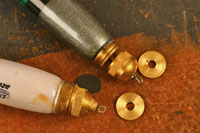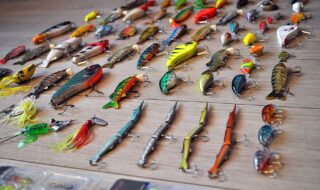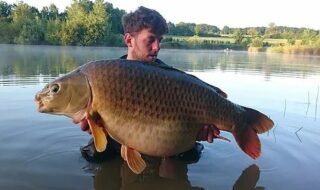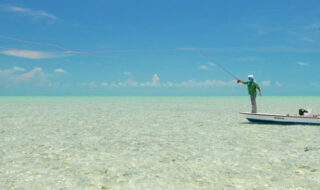Gareth Purnell Reports
When you get robbed on your first night in a new country, it can hardly be called the ideal start. Absolutely knackered after a 30-hour journey in our Captiva, kindly leant to us by Chevrolet for the event, we found our digs overlooking Hungary’s Lake Velence, unloaded what we could and crashed out.
And while we dreamed of what we would catch in the coming week, we were broken into, and some 30,000 Euros worth of tackle and photographic equipment was swiped from under our noses.
So it was that a Sunday that was meant to be about settling in and getting ready for the five official practice days that precede the two-day world championships, was spent down the local nick. The cops told us that the value of our loss amounted to the price of a small house in Hungary! Though no doubt it was sold at a local market for a fraction of what it was worth.
As well as cameras, rods, poles, all my rigs, pole floats and line etc, they even nicked a polystyrene box containing 10kg of worms provided to us at a knock down price for the event by Willis Worms! These turned up a couple of days later not too far away and it was at this point we were glad we’d not caught them in the act. The packing tape had been sliced cleanly through with a sharp knife…
But we were there to fish and to compete and you have to make do. The England lads kindly leant us what they could so we could get going and come the Monday we were at least ready to have a go.
Lake Velence is a huge lake with a small section adapted as a rowing course, and it’s here that matches are held. I fished in the world championships here in 1997 when Alan Scotthorne took the individual gold and England the silver medal. Then it was a case of targeting skimmers on top of the shelf and carp over it.
After just one day of practice it was clear that there was nothing to be caught on top of the shelf other than tiny ruffe and a few bleak.
 |
| Lake Velence in Hungary – it was to prove a very different proposition to the last time the World Champs were held there in 1997. |
There was a big ledge at anywhere between 10 and 18 metres out. With a pole limit these days of 13m (compared to 14.5m in 1997) it was a case of fishing over if you couldn’t reach, or using a long line and swinging it out over the ledge with a 3gr float to target to carp.
The technique that had worked in the Hungarian trials was to attack the pole line with a coarse groundbait loaded with corn and chopped worms, and then feed it with small balls of sticky mag during the match with a view to catching carp in the last hour.
You fished a big hook like a size 10 Animal loaded with up to ten maggots to mimic a ball of sticky mag, and needed at least 0.18mm line as the ledge was sharp and lighter line could easily break if rubbed against it.
It sounded great, and I’d caught carp over the ledge in the match in 1997 so I was happy with that. But the weather had other ideas.
The 1997 event had been held mid-summer (something I’d forgotten until reminded by England manager Mark Downes), and the carp fed well.
This time around though, the day after our arrival the temperature plunged from 22 degrees to 10 degrees. It stayed that way all week, and the carp simply refused to play ball.
So after just a day of practice, it was obvious that the waggler line was vital, and as people fed there all week it became a kind of self-fulfilling prophecy. Fish didn’t need to come in close to get food, so they didn’t.
As the week developed the competitors honed their long range waggler skills, fishing at 35-40m. It was quite technical fishing. You needed to fish big floats – 12gr was ideal – but in the main you were targeting skimmers up to about 12oz, which are a shy biting fish at the best of times. And before you ask why we didn’t just fish the feeder, any form of legering is banned at world level.
That made float choice and shotting very important, and plumbing up accurately vital. The two ways of approaching the waggler line were with a fixed float and a slider. You had to fish over a second ledge, which was about 35m out, but it wasn’t too deep and a 14ft waggler rod was fine for the fixed float set-up.
I caught best with the fixed float unless it was towing hard. I hadn’t seen the wagglers we all ended up using before. As you can see from the diagrams, the key feature of the Dino Record and Exner Dream floats I used is the thin carbon stem between the peacock quill body and the bristle – much more sensitive than peacock all the way through.
The floats have removable brass discs at the base and through trial and error I found that having around four No4 shot down as a bulk plus a dropper below was the most you could get away with and still consistently get bites from the skimmers.
Fixed Dino Float Set-Up

As you can see from the rig diagram, the shotting was positive in terms of getting the bait down quickly, with a bulk of shot then a swivel and a No6 shot together. The swivel was important to prevent line spin of the hooklength, but plumbing up accurately was critical. This shot and swivel needed to be off bottom, but only just, so that lift bites registered immediately, and obviously.
Hooklengths needed to be short too, with only around three to four inches of line on the bottom. Skimmers are quick to drop a bait at the best of times but when they have been fished for hard all week, doubly so. You needed the fish to pick up the hook and lift the dropper shot in one movement. The float tip would rise just enough to see at distance, and that’s when you needed to strike.
If the water was still out there the solid plastic float tips were best. These were more sensitive and clearly registered when the No6 dropper shot lifted up. But when it towed a bit they dragged under straight away and the hollow plastic tips on the Dino Record floats held up better. I really like these. They have a small piece of balsa in the base of the hollow tip to further increase buoyancy and even in a medium tow still did the job.
When the wind blew along the venue and the water towed hard in the opposite direction however, neither was any good and that’s when the slider came into its own. With more weight down in the form of a big olivette, the float moved through the swim much more slowly giving much better presentation.
They were easier to cast a long way than the fixed floats too, but most importantly the peacock stem, being much more buoyant than the arrangement on the other floats, meant the bristle didn’t drag under and therefore you could fish more of your tight 10-yard zone effectively.
Fixed Or Sliding?
 |
| Gareth used the Cralusso waggler attachments for his fixed waggler rigs. The line is wrapped once around the barrel to lock it. |
|
 |
| Shotting was quite positive with a bulk only just above the dropper shot and swivel. But if you put too much weight down the skimmers dropped the bait. |
|
 |
| Floats were set so that the swivel and the dropper shot were only just off bottom so that lift bites were clearly registered. |
|
 |
| As insurance Gareth locked a Stotz on the line below the float, and marked the depth above it with a sliding stop knot. |
|
|
|
Line choice proved important too, and I went through several brands as the week progressed. The tow was in the upper part of the water and to get the best presentation you needed a line that sank well below it. But you didn’t want too much stretch or you’d miss the quick skimmer bites.
My two favourites for doing this and allowing me to easily get to the clipped-up distance with 10gr and 12gr floats proved to be good old 3lb Maxima and the 3-4lb Daiwa Matchwinner given to me by Will Raison. If I hadn’t had all my Preston Powerline nicked, the 0.13mm and 0.15mm would have worked fine as well. Any line with buoyant properties was useless.
And so to feeding. Sensas, as they always do, had kindly provided us with what they and we thought we’d need, a selection of Sensas Lake, Sensas Carp Fine, damp leam and some soil. It was hard to work anything out though. Fish seemed to be in pockets and if you were on them you caught whatever you did. If you were unlucky there wasn’t a lot you could do, as Stu Conroy, one of the best slider anglers in England, proved on the first match day when he could only put 60gr in the net on section E.
But if 13 world championships have taught me anything it’s that if you feed fish bloodworm and joker, then that’s all they want. If it had been just skimmers we were after we’d have fed no groundbait at all, but the fly in the ointment were carassio carp. They seemed to respond to a bit of groundbait and they weighed really well. Out of the blue you could catch two in two casts, and then they were gone.
Getting The Balance Right
 |
| When the venue was still, the very sensitive solid plastic tip on the Exner Beam floats was the way to go. These showed up lift bites brilliantly. When it was towing a bit, the hollow plastic tips on the Dino Record floats was better as they allowed you to fish overdepth without the float dragging under. If it was towing hard you needed the buoyancy of a full peacock quill slider (above) to drag bottom without the float pulling under. |
|
 |
| Removable brass discs in the bases of the floats allowed you to play with how much weight you had down, but the skimmers wouldn’t stand for too much on the fixed set-up. |
|
We settled on a feed mix of five parts Sensas damp leam and terre de rivierre to one part Sensas Lake, fed so that it would go down well and make a good noise as it hit the water but break up a bit before it got to the silt on the bottom. The use of a bit of chopped worm had proved completely inconclusive, and in the end I left it out, feeding just joker and a bit of bloodworm.
The match went well for me. Drawn in a tough E section on the first day, I hadn’t had a bite in the first 40 minutes. But I stuck with the plan of topping up with three balls of the soil and joker every cast, and a big skimmer half way through settled the nerves and helped me to a joint 10th in section, beating the Dutch angler to my left. With two of the other lads also getting in the top 15, Team USA was actually ahead of France after day one in 14th place of the 40 teams (a record entry).
 |
| The match played into the hands of master slider angler Alan Scotthorne, pictured here connecting with a fish at long range. |
Leading the way after day one, as expected, were the Hungarians – all their anglers finishing in the top ten in their sections, with Belgium second, Italy third and England, having to carry Stu’s 37th in section, a disappointing seventh, a massive 45 points behind the leaders.
Day two saw me in D section and a check on the previous day’s results showed that it was a bad draw, at the wrong end of the section where all the anglers had really struggled. However, I’d spoken to Stu after the match and he said that the fish are on the move all the time, and you could never really tell where they would be. I told myself that as I made my way to the peg.
The wind was blowing hard from right to left on day two, making casting and presentation hard, but I was pleased to get an early skimmer and then two quick carassio settled my nerves before a tangle (angler error!) forced me to stop fishing for ten minutes going into the last half hour as I set up again. It proved to be a blessing because it stopped me feeding, and first cast back in I caught a nice skimmer.
I was still struggling a bit in the section though, but I took a chance and stopped feeding for the last 15 minutes, and right on the hooter that signals five minutes remaining, the float buried, and I latched into the best fish I’d hooked all week. I thought it was a carp to be honest, as it took some line, and I was glad I’d switched from the very soft 0.92mm Sensas Feeling hooklength to the more robust 0.10mm Ultima Power Match after the tangle. The old ticker was in the mouth as I brought the fish over the ledge but luckily it wasn’t a huge fish and a carassio of about 1lb 10oz was in the net. It had to be – there’s no time allowed to play hooked fish in the world champs. If the fish in not in your ‘possession’ on the final hooter, it doesn’t count.
I felt a little guilty as I meant I beat the Welsh angler to the left, especially later when I found out they’d missed out on a medal by half a point. But on a personal level I was pleased as my 2 kilo odd weight put me 15th in my section and meant I just made the top 50 overall – a tough task when you’re fishing at this level. Sadly three of the team blew out on day two and Team USA fell away a bit, finishing in 25th place.
To everyone’s surprise Hungary slipped to third with Italy taking the gold and Belgium the silver. Italy fished with quite a cute ‘semi sliding’ rig that I’m not sure many people know about. It allowed them to hit more bites by striking straight into the fish and not through the float, but yet still not have too much weight down.
England finished second on day two but had just too much to make up, and finished in fifth. But there was much to cheer as that master long range slider angler Alan Scotthorne took gold – becoming the only angler to claim a fifth world crown. Amazing.
Interestingly England hardly fed anything – five out of six balls were just soil with no joker, designed only to bring fish into the area with the noise.
I’m left with a sour taste at losing so much gear and we were not alone either. The Bosnian team had all their tackle stolen too. Someone knew what they were doing.
But my lasting impression is positive of the venue on which I caught well all week and in the match. It was technical long range float fishing of the type we never really get to do here these days because we allow feeder fishing. I for one wish more events were fished to international rules here in the UK. Roll on Italy next year.
With thanks…
With all the gear you need for a world champs it takes a big car to handle everything three anglers take with them, but the two-litre Chevrolet Captiva SUV diesel coped with this and the 2,500 miles round trip effortlessly, with a little help from two Thule roof boxes.
It’s a cracking angler’s car and it’s good on fuel too.
The team travelled over the channel with P&O, who are currently advertising Dover-Calais crossings from £30.
Many thanks also to Sensas and to Denzil Thorpe from Willis Worms too for providing groundbait and worms for the match and practice – pity those carp decided not to feed Denzil!
More information: www.chevrolet.co.uk, www.willisworms.co.uk, www.poferries.com
The 2007 World Champs In Pictures
 |
| Well the Chevrolet Captiva has done us proud and some 30 hours after setting off and with a bit of kip in the car somewhere in Germany in between, we’ve arrived at Lake Velence. |
|
 |
| Opening parade reveals a record entry this year of 40 teams. Team USA is somewhere at the back there… |
|
 |
| That’s us next to Wales and team manager Eric Humphries, who is to go within a whisker of leading his team to a medal. |
|
 |
| The first of five official days of practice is under way (this is the Hungarian team, who were strong favourites) and the teams quickly realise that there’s jack all to be caught on the pole line… |
|
 |
| The night before the big match and the laborious task of mixing up the leam and soil goes on well into darkness. |
|
 |
| Well we’re not using any chopped worm but a certain Alan Scotthorne obviously is – possible error? |
|
 |
| Each angler has a steward and every angler is checked before the match to make sure they haven’t exceeded their 17-litre groundbait limit and their joker and hook bait limits. |
|
 |
| I’m in E section on day one – the same as Stu Conroy. But he really struggles and only weighs in 60gg for 37th in section. England’s defence of the gold they won in Portugal is in trouble. |
|
 |
| A big skimmer half way through the match helps me to a joint tenth in section – I’m happy with that. |
|
 |
| Two more of the Team USA lads are in the top 15 too. When the results come out we can’t believe that we’re ahead of France! |
|
 |
| Day two sees Des Shipp come into the England team and he fishes like a star to win his section. It’s too late for England though and they can only manage fifth overall. |
|
 |
| I’m at the wrong end of D section judging by the day one results. But two carassio in quick succession settle the nerves… |
|
 |
| Word comes down the bank that Alan Scotthorne is catching long on the slider in A section. He finished second in his section on the first day. |
|
 |
| A crowd is gathering behind Alan. It’s going to be tight. Can he win again on Lake Velence as he did in 1997? Hang on,.. is that one of the cameras I had nicked?! |
|
 |
| A late carassio sees me pick up several places for 15th in section. It puts me in the top 50 overall. That’s tough in this match and I’m delighted with it. |
|
 |
| Alan weighs in just short of five kilos for third in section. Five points over the two days isn’t normally enough to become individual champion, but it could be on this difficult venue. |
|
 |
| A massive cheer comes through as the jungle drums confirm that he’s done it – and 2006 world champ Tamas Walter from the Hungarian team is among the first to congratulate him with wife Sandra looking proudly on. |
|
 |
| This is a team event though and the Italians are awesome on day two, scoring only 23 points. They take the gold medal from Belgium with Hungary only just seeing off Wales for the bronze by half a point. |
|
 |
| Shimano Team Wales manager Eric Humphries is gutted at just missing a medal, but an individual bronze medal for team member Lee Edwards does at least put a smile on his face. |
|
 |
| History maker! Will anyone ever match or beat Alan Scotthorne’s incredible feat of five individual world championship crowns? |
|



































